Caryn’s Thoughts
 At this time of year, many people turn their attention to the fine art of…hunting. And my nephew, Ryan Hadlock is no exception to that rule. This year, Ryan’s interest has turned to duck hunting. While any kind of hunting is a challenge, I think it would be especially difficult to shoot a flying target. I love to take pictures of birds, especially in flight, but they are hard to capture. The camera gives me far more chances to capture a bird in flight than someone with one bullet at a time. For that reason, I have to respect someone who can shoot a bird in flight. I don’t think that is such an easy thing to do.
At this time of year, many people turn their attention to the fine art of…hunting. And my nephew, Ryan Hadlock is no exception to that rule. This year, Ryan’s interest has turned to duck hunting. While any kind of hunting is a challenge, I think it would be especially difficult to shoot a flying target. I love to take pictures of birds, especially in flight, but they are hard to capture. The camera gives me far more chances to capture a bird in flight than someone with one bullet at a time. For that reason, I have to respect someone who can shoot a bird in flight. I don’t think that is such an easy thing to do.
Ryan is a great husband to his wife, Chelsea, and a great dad to his children, Ethan and Aurora. Those are the most important jobs of his life, even if they don’t feel like work. Ryan and Chelsea have always had a lot in common, and that made them compatable from the very start. Sharing your life with someone is easy, when you are both going the same direction. Then, when they had their children, they both showed everyone what great parents they are. Ethan and Aurora are wonderful kids with good manners and sweet personalities, even if they do take after their dad in the teasing department.
Of course, it could be all in the way Ryan was raised…and I don’t mean by his parents. Ryan is the only boy in a family of four children. His sisters have picked on him unmercifully. Not in a mean way, of course, it’s just the way that family functioned. And don’t get the idea that Ryan couldn’t dish it out, because he could. One time he told his youngest sister, Kellie not to dance with boys at the prom. Needless to say, her date was…you guessed it…a boy!! Everyone in this family teased everyone else. Ryan was slightly outnumbered, however. I’m not so sure that really mattered, but the girls did try to gang up on him some. And, even when it comes to his birthday card, which his sisters, Jessi and Kellie laughed about uncontrollably for the entire day. The card read, “Once upon a time, a very special person was born, who was destined to change the world.” And inside it said, “Calm down, it’s not you, it’s Jesus. I think he’d want you to have a happy birthday though.” You have to admit…it was funny!!
As to the serious side of Ryan, if there is one, he loves his job and works very hard at it. Ryan is a compression operator for FDL Energy, LLC. FDL Energy bought Anadarko which is where my brother-in-law, Mike Stevens and also Ryan work. In fact, Mike is Ryan’s supervisor, and they both get along very well. Gas compressor 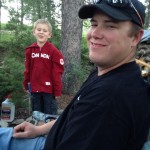 operators follow a schedule provided by petroleum engineers or production supervisors to operate compressor engines, pumps and auxiliary equipment in a way that allows for appropriate flows of gas. They are responsible for adjusting controls and valves, regulating pressures and monitoring meters. Gas compressor operators keep records of meter and gauge readings to determine the temperature, amounts of gas received and dispensed, pressure and consumption rate variations. They may also collect gas samples for laboratory testing. I’m not sure how much of that Ryan does, but it was interesting to learn about his job. Ryan is a man of many skills. He can learn just about anything he sets his mind to. That’s what makes him a great employee. Today is Ryan’s birthday. Happy birthday Ryan!! Have a great day!! We love you!!
operators follow a schedule provided by petroleum engineers or production supervisors to operate compressor engines, pumps and auxiliary equipment in a way that allows for appropriate flows of gas. They are responsible for adjusting controls and valves, regulating pressures and monitoring meters. Gas compressor operators keep records of meter and gauge readings to determine the temperature, amounts of gas received and dispensed, pressure and consumption rate variations. They may also collect gas samples for laboratory testing. I’m not sure how much of that Ryan does, but it was interesting to learn about his job. Ryan is a man of many skills. He can learn just about anything he sets his mind to. That’s what makes him a great employee. Today is Ryan’s birthday. Happy birthday Ryan!! Have a great day!! We love you!!

 Some babies are able to capture your heart with their funny little ways. They are always smiley and always up to something. They seem to have the ability to do things that make people laugh, and it all seems to be instinct to them. No amount of planning on the part of their parents, is needed. My cousins, Chris and Annie Beadle have just such a baby. His name is Kasen, and he reminds me a lot of my oldest grandson, Chris, who was just such a baby too. Kasen has great big, expressive eyes, and an almost shy look about him, although he certainly isn’t shy around the camera, and in fact, he will steal your heart in an instant. That’s just the kind of baby Kasen is.
Some babies are able to capture your heart with their funny little ways. They are always smiley and always up to something. They seem to have the ability to do things that make people laugh, and it all seems to be instinct to them. No amount of planning on the part of their parents, is needed. My cousins, Chris and Annie Beadle have just such a baby. His name is Kasen, and he reminds me a lot of my oldest grandson, Chris, who was just such a baby too. Kasen has great big, expressive eyes, and an almost shy look about him, although he certainly isn’t shy around the camera, and in fact, he will steal your heart in an instant. That’s just the kind of baby Kasen is.
He is a busy little boy, who always has things to do, and you truly don’t know what he will be up to next…until you see his mom’s pictures that is. As I said, Kasen seems to have a shy demeanor, but I don’t think he is  really very shy. He plays well with his sister and friends, and really loves just being a big boy…now that he can walk. He loves his big sister, Nevada, and she loves helping out with Kasen. I think Nevada has wanted a little brother or sister for a long time, so she is really enjoying Kasen. Of course, he hasn’t had the chance to get into her things yet, so we will see how she feels about him in the future. I’m sure there will be those horrible years when she wishes they could send him back, but in the end, I think little Kasen will win his sister’s heart, just like he has every other heart he has ever set out to win with his quick smile and his big eyes.
really very shy. He plays well with his sister and friends, and really loves just being a big boy…now that he can walk. He loves his big sister, Nevada, and she loves helping out with Kasen. I think Nevada has wanted a little brother or sister for a long time, so she is really enjoying Kasen. Of course, he hasn’t had the chance to get into her things yet, so we will see how she feels about him in the future. I’m sure there will be those horrible years when she wishes they could send him back, but in the end, I think little Kasen will win his sister’s heart, just like he has every other heart he has ever set out to win with his quick smile and his big eyes.
These days, Kasen is content to play with his own toys, and I’m sure that his sister’s big 4th grader things aren’t too interesting. But then, she might have a very different take on that than what I see. I’m also sure that his daddy, Chris can’t wait to be able to get his son out there ad teach him how to play baseball or football, or at the very least watch their favorite Denver Broncos together, because that’s 
 what fathers and sons do, after all.
what fathers and sons do, after all.
Kasen is a sweetheart, as I said, and I have to admit I am quite a fan of this little cutie. I love how he entertains those around him and I love that his mommy, Annie posts so many pictures to keep me updated. If I ever need something to make me smile, I just go to Annie’s Facebook page and have a look at the pictures she has posted of little Kasen, and then I smile and go on about my day. Today is Kasen’s 1st birthday. Happy birthday Kasen!! Have a great day!! We love you!!
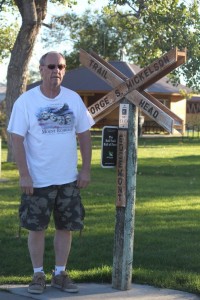
 Over the years of my childhood, my dad, Allen Spencer would tell my sisters and me a story about his walk to and from school as a kid. He always said that he and his siblings, Bill and Ruth had to walk five miles through the snow to get to school, and it was uphill both ways. Of course, my sisters and I didn’t believe Dad’s stories…then. And my sisters still might not believe it, but I’m here to tell you that there are certain conditions in which such a journey might actually be uphill both ways, or at least seem like it.
Over the years of my childhood, my dad, Allen Spencer would tell my sisters and me a story about his walk to and from school as a kid. He always said that he and his siblings, Bill and Ruth had to walk five miles through the snow to get to school, and it was uphill both ways. Of course, my sisters and I didn’t believe Dad’s stories…then. And my sisters still might not believe it, but I’m here to tell you that there are certain conditions in which such a journey might actually be uphill both ways, or at least seem like it.
On Saturday, Bob and I headed up to Hot Springs, South Dakota to do some hiking. Our plan was to finish the last 13 miles (26 miles, since we would hike out and back, thereby doing the 13 miles twice) of the Mickelson Trail. The Mickelson Trail is 109 miles one way, and with this last leg of the hike, we will have hiked the entire trail twice, for a total of 218 miles, because of the walk out and back.
Saturday turned out to be the hottest day of the three days we hiked…well over 80. To top it off, we didn’t get started until 1:30 pm, because of our drive over. Well into the heat of the day. We were hiking a five mile stretch, or ten miles total. As we walked, we were thankful that since we were going uphill the whole way over, we would be going down hill the on the way back…or so we thought. It was very hot all day, and several times we thought the trail ahead looked like a down hill slope, only to find that it was not. As the day grew hotter, we started back…noticing as we did, that we were still going uphill. My thoughts drifted back to all those times when my dad had told us his famous story about walking those 5 miles to school on the snow, uphill both ways. I think I now understand that while it couldn’t have been uphill both ways, to a kid walking to school, it could certainly seem like it was uphill both ways. Our hike on Saturday, couldn’t have been uphill both ways either, but somehow in the heat of the day, the trail caused an optical illusion that made it seem like it was uphill on the way over, when in fact it 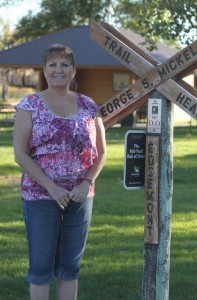
 was downhill a good portion of it. Now we were faced with an unexpected uphill hike back.
was downhill a good portion of it. Now we were faced with an unexpected uphill hike back.
The hike Sunday and the one today were far more pleasant, and the really good news is that as of 10:00 this morning, Bob and I can say that we have hiked the entire Mickelson Trail, from Edgemont to Deadwood…twice. It is a wonderful feeling of accomplishment that we have today. It took us a few years…about 15, I would say, but since we don’t live in the area, that’s not too bad. There were beautiful sections, where we walked for hours through the trees, and boring times, when we found ourselves hiking along the highway, but all in all it was a great journey. Would I do it again? Hmmmm, maybe some sections. Others…well, I don’t think so. Nevertheless, if there was another trail like it, I might consider it. Call me crazy.
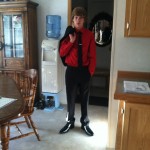 My nephew Riley Birky is growing up so fast, in fact, I can’t believe how tall and adult like he is getting. Riley is a Freshman this year, and that has given him a chance to learn public speaking. Public speaking, to me is a subject that should only be taken by those who truly want to become public speakers. I am definitely not one of those people. I’m far to shy for it, and from what I hear, Riley and I have that in common. I hope for Riley’s sake that he can overcome that shyness, because it is hard to live with.
My nephew Riley Birky is growing up so fast, in fact, I can’t believe how tall and adult like he is getting. Riley is a Freshman this year, and that has given him a chance to learn public speaking. Public speaking, to me is a subject that should only be taken by those who truly want to become public speakers. I am definitely not one of those people. I’m far to shy for it, and from what I hear, Riley and I have that in common. I hope for Riley’s sake that he can overcome that shyness, because it is hard to live with.
Public speaking is quite possibly the only thing that Riley is shy about. He has be practicing Tae Kwon Do for two and a half years now. He loves the challenge of fighting, so the next logical step was for him to start boxing. He is pretty excited about learning to box. While Tae Kwon Do, Judo, boxing, or any other form of fighting is not my cup of tea, I have to say that they are very interesting to watch. It takes a great degree of skill to learn these arts, and a lot of dedication and discipline. I think Riley has those traits, and that they will take him far.
Riley loves music, especially Rap music. Personally, I could never see the draw that Rap music has, but then I am not a teenager. It seems to me that every generation has a new type of music. I know my own parents absolutely hated the Rock music my sisters and I listened too, and now that I’m a grandmother, I personally go for Country music, so now I can agree with my parents’ thoughts on Rock, or any of the other music of today’s generation…sorry Riley.
 Riley may be growing up fast and spreading his wings in many ways, but one thing has never changed. Riley loves his mom and his little brother, Tucker. He may not always see eye to eye with them, but he loves them nevertheless. Riley is also loves his dad, sister and family, and gets along well with his stepdad, my brother-in-law, Ron. The teen years are tough, no matter who you are. Lots of changes are going on within you, and you are trying decide who and what you are going to be. Riley still has time to make the choices about his future that are his alone to make, and I’m sure that he will be a success in whatever career choice he makes. He is a kind and loving young man, and that will carry him a long way…no matter what he decides to do with his life. Today is Riley’s birthday. Happy birthday Riley!! Have a great day!! We love you!!
Riley may be growing up fast and spreading his wings in many ways, but one thing has never changed. Riley loves his mom and his little brother, Tucker. He may not always see eye to eye with them, but he loves them nevertheless. Riley is also loves his dad, sister and family, and gets along well with his stepdad, my brother-in-law, Ron. The teen years are tough, no matter who you are. Lots of changes are going on within you, and you are trying decide who and what you are going to be. Riley still has time to make the choices about his future that are his alone to make, and I’m sure that he will be a success in whatever career choice he makes. He is a kind and loving young man, and that will carry him a long way…no matter what he decides to do with his life. Today is Riley’s birthday. Happy birthday Riley!! Have a great day!! We love you!!
 My nephew, Steve Moore, who married my niece Machelle Cook Moore, is a gun enthusiast…and that is putting it mildly. Steve has a real passion for gun making, and in all reality, wants to make guns for a living. According to Machelle, he has a real knack for it. One of my Spencer ancestors made a rifle that ended up making a huge difference in the Civil War. I have to wonder if someday, we won’t have a well known gun called the Moore Special or something. Now, I can’t say whether the Moore Special would be a rifle or a hand gun, and I can’t tell you what caliber it would be, but I can tell you that it would either come equipped with a silencer, or a silencer would be an add on option, because Steve is a big fan of the silencer. Steve struggles with his hearing because of the noise guns make, and he doesn’t want his boys, Weston and Easton to have the same problems. For that reason, and the fact that both of his boys are becoming total gun enthusiasts too, Steve wants to do everything he can to protect their hearing, while allowing them to enjoy guns as much as he does. So, Steve has made sure that he has enough silencers so that they can practice their shooting without having to change out the silencers all the time. The silencers have also earned him an A+ with his mother-in-law, Debbie Cook, who doesn’t like the loudness of the guns when the guys are shooting, which she feels disturbs the serenity of their camping spot, which is the main reason people go camping, right.
My nephew, Steve Moore, who married my niece Machelle Cook Moore, is a gun enthusiast…and that is putting it mildly. Steve has a real passion for gun making, and in all reality, wants to make guns for a living. According to Machelle, he has a real knack for it. One of my Spencer ancestors made a rifle that ended up making a huge difference in the Civil War. I have to wonder if someday, we won’t have a well known gun called the Moore Special or something. Now, I can’t say whether the Moore Special would be a rifle or a hand gun, and I can’t tell you what caliber it would be, but I can tell you that it would either come equipped with a silencer, or a silencer would be an add on option, because Steve is a big fan of the silencer. Steve struggles with his hearing because of the noise guns make, and he doesn’t want his boys, Weston and Easton to have the same problems. For that reason, and the fact that both of his boys are becoming total gun enthusiasts too, Steve wants to do everything he can to protect their hearing, while allowing them to enjoy guns as much as he does. So, Steve has made sure that he has enough silencers so that they can practice their shooting without having to change out the silencers all the time. The silencers have also earned him an A+ with his mother-in-law, Debbie Cook, who doesn’t like the loudness of the guns when the guys are shooting, which she feels disturbs the serenity of their camping spot, which is the main reason people go camping, right.
Steve has set a goal for himself to open his own business. He wants to build guns for people, and eventually also repair guns for people. Of course, there is a lot of legal red tape to go through in order to be a gun builder and seller. The first step is FBI approval of Steve’s form 4s, which allows him to sell to people. There will be more forms to fill out in order to repair guns. Of course, Steve will also be making other types of parts for people too. He is very talented when it comes to building parts for just about anything. They recently bought a lathe to start preparing for the business to come. In the meantime, Steve can make just about anything on it. All of his friends know that if they need a part made, Steve is their man. He recently build a part for Machelle’s Uncle Ron’s lift. The request came on one camping trip and the part was ready by the next camping trip.
 Camping is, of course, Steve’s favorite thing to do whenever he is off work. He and Machelle bought a trailer and pickup from Ron his wife Rachel, because their boys were getting too big for the little camper they had before. Whenever Steve isn’t working on guns, he is thinking about camping and shooting contests, or going camping and to shooting contests. I guess that just stands to reason though. When guns are your passion, guns are what you think about. In the end, I think it will be a good business for Steve to get into, because I think as time goes on, more and more people are going to be buying guns. It is an unfortunate side effect of the world we live in. People need guns to protect themselves and their families. Today is Steve’s birthday. Happy birthday Steve!! Have a great day!! We love you!!
Camping is, of course, Steve’s favorite thing to do whenever he is off work. He and Machelle bought a trailer and pickup from Ron his wife Rachel, because their boys were getting too big for the little camper they had before. Whenever Steve isn’t working on guns, he is thinking about camping and shooting contests, or going camping and to shooting contests. I guess that just stands to reason though. When guns are your passion, guns are what you think about. In the end, I think it will be a good business for Steve to get into, because I think as time goes on, more and more people are going to be buying guns. It is an unfortunate side effect of the world we live in. People need guns to protect themselves and their families. Today is Steve’s birthday. Happy birthday Steve!! Have a great day!! We love you!!

![is[3]](https://carynschulenberg.com/wp-content/uploads/2015/10/is3-e1444346657892-150x150.jpg) Most of us give little thought to things falling from the sky, but the reality is that it does happen, and more often than we think. There have been times when planes have fallen from the sky, satellites, and even space shuttles. One thing that we really don’t think about is meteors, but they too fall from the sky. We live in a solar system, and there are many objects in space that, if they get too close to our atmosphere, can get caught in it and fall to Earth. Most often these items are small enough to simply burn up in our atmosphere, and we view them as shooting stars, but some actually make it to Earth’s surface. I can think of a famous meteor, whose crater I was able to see when I was a kid. It is the crater that is located in Arizona, near Winslow. It is unknown how big that meteor was, because there is no documentation. Many people have suggested that it was quite small, but in light of more recent meteor hits, I have to wonder if it was bigger than they think. Of course, years ago, I might have accepted the theory that a meteor the size of a golf ball could make a hole the size of the crater in Arizona, but after seeing some of the more recent strikes, that just no longer seems logical, and my brain, being very logically wired, simply can’t buy into that, given the current knowledge that I have.
Most of us give little thought to things falling from the sky, but the reality is that it does happen, and more often than we think. There have been times when planes have fallen from the sky, satellites, and even space shuttles. One thing that we really don’t think about is meteors, but they too fall from the sky. We live in a solar system, and there are many objects in space that, if they get too close to our atmosphere, can get caught in it and fall to Earth. Most often these items are small enough to simply burn up in our atmosphere, and we view them as shooting stars, but some actually make it to Earth’s surface. I can think of a famous meteor, whose crater I was able to see when I was a kid. It is the crater that is located in Arizona, near Winslow. It is unknown how big that meteor was, because there is no documentation. Many people have suggested that it was quite small, but in light of more recent meteor hits, I have to wonder if it was bigger than they think. Of course, years ago, I might have accepted the theory that a meteor the size of a golf ball could make a hole the size of the crater in Arizona, but after seeing some of the more recent strikes, that just no longer seems logical, and my brain, being very logically wired, simply can’t buy into that, given the current knowledge that I have.
One of those more recent meteor strikes happened on this day, October 9, 1992, when a meteor about the size  of a bowling ball, came crashing down, and sliced right through a 1980 Chevy Malibu owned by Michelle Knapp. Michelle was watching television in her parents’ living room in Peekskill, New York when she heard a thunderous crash in the driveway. Wondering what could have happened, Michelle ran outside to check it out. What she found was shocking. There was a large hole in the rear end of her car, and a matching hole in the gravel driveway underneath the car. It was what was in the hole that was the most shocking, however. A rock about the size of a bowling ball, but, at a weight of 28 pounds, it was much heavier than a bowling ball, which can only weigh a maximum of 16 pounds. The rock was shaped like a football and warm to the touch, but the worst part was that it smelled like rotten eggs. Of course, this was all big news in the world of science, and the next day, a curator from the American Museum of Natural History in New York City confirmed that the object was a genuine meteorite. I’m sure that of all the things Michelle could have imagined hitting her car, a meteor was most likely the last.
of a bowling ball, came crashing down, and sliced right through a 1980 Chevy Malibu owned by Michelle Knapp. Michelle was watching television in her parents’ living room in Peekskill, New York when she heard a thunderous crash in the driveway. Wondering what could have happened, Michelle ran outside to check it out. What she found was shocking. There was a large hole in the rear end of her car, and a matching hole in the gravel driveway underneath the car. It was what was in the hole that was the most shocking, however. A rock about the size of a bowling ball, but, at a weight of 28 pounds, it was much heavier than a bowling ball, which can only weigh a maximum of 16 pounds. The rock was shaped like a football and warm to the touch, but the worst part was that it smelled like rotten eggs. Of course, this was all big news in the world of science, and the next day, a curator from the American Museum of Natural History in New York City confirmed that the object was a genuine meteorite. I’m sure that of all the things Michelle could have imagined hitting her car, a meteor was most likely the last.
Apparently, our earth is bombarded with about 100 pounds of meteoric material every day, however. Some are the size of dust particles, and some as big as 10 miles across, with the average being about the size of a basketball. So I guess that Michelle’s meteor wasn’t all that unusual. Meteors seem to be in the news more and more these days, and with the invention of dash mounted video cameras and other such surveillance 
 equipment, meteor strikes have been caught on camera, that never were before. Of course, any strikes that hit something were usually found, but those that didn’t might not have been known. I hadn’t really given much thought to the many times our planet has been hit, but it stands to reason that with all the space debris, it is a possibility. Personally, I hope that my car never has to sustain a hit like that, but I suppose that she got enough out of the incident, with the fame and all, to buy herself a new car…or maybe she had insurance on it and got it covered that way. As for me…I’ll just keep my car.
equipment, meteor strikes have been caught on camera, that never were before. Of course, any strikes that hit something were usually found, but those that didn’t might not have been known. I hadn’t really given much thought to the many times our planet has been hit, but it stands to reason that with all the space debris, it is a possibility. Personally, I hope that my car never has to sustain a hit like that, but I suppose that she got enough out of the incident, with the fame and all, to buy herself a new car…or maybe she had insurance on it and got it covered that way. As for me…I’ll just keep my car.
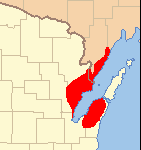 I think most people have heard of the Great Chicago Fire of 1871, but few have heard of the Great Peshtigo Fire of 1871, that started the same day, October 8, 1871. I’m sure that Chicago, being a much bigger city, made it a fire that stuck in the minds of the people, but in reality, the Great Peshtigo Fire was far more deadly. The Chicago fire burned an area about four miles long and almost a mile wide through the Windy City, including its business district. The fire destroyed thousands of buildings, killed an estimated 300 people and caused an estimated $200 million in damages. That is a horrible fire, and a horrible loss of life and property, but it truly pales in comparison to the Great Peshtigo Fire. The Great Peshtigo Fire took place in the area around Peshtigo, Wisconsin and the death toll was estimated at around 1,500 people, and possibly as many as 2,500. I suppose that it seems odd for the estimate to be a difference of as many as a thousand people, but when the fire was finally out, twelve communities were destroyed. An accurate death toll has never been determined because local records were destroyed in the fire. Between 1,500 and 2,500 people are thought to have lost their lives. The 1873 Report to the Wisconsin Legislature listed 1,182 names of deceased or missing residents. In 1870, the Town of Peshtigo had 1,749 residents. More than 350 bodies were buried in a mass grave, primarily because so many had died that no one remained alive who could identify many of them. In the end, over, 1,875 square miles, or 1.2 million acres of forest had been consumed, an area approximately twice the size of Rhode Island. Some sources list 1.5 million acres burned.
I think most people have heard of the Great Chicago Fire of 1871, but few have heard of the Great Peshtigo Fire of 1871, that started the same day, October 8, 1871. I’m sure that Chicago, being a much bigger city, made it a fire that stuck in the minds of the people, but in reality, the Great Peshtigo Fire was far more deadly. The Chicago fire burned an area about four miles long and almost a mile wide through the Windy City, including its business district. The fire destroyed thousands of buildings, killed an estimated 300 people and caused an estimated $200 million in damages. That is a horrible fire, and a horrible loss of life and property, but it truly pales in comparison to the Great Peshtigo Fire. The Great Peshtigo Fire took place in the area around Peshtigo, Wisconsin and the death toll was estimated at around 1,500 people, and possibly as many as 2,500. I suppose that it seems odd for the estimate to be a difference of as many as a thousand people, but when the fire was finally out, twelve communities were destroyed. An accurate death toll has never been determined because local records were destroyed in the fire. Between 1,500 and 2,500 people are thought to have lost their lives. The 1873 Report to the Wisconsin Legislature listed 1,182 names of deceased or missing residents. In 1870, the Town of Peshtigo had 1,749 residents. More than 350 bodies were buried in a mass grave, primarily because so many had died that no one remained alive who could identify many of them. In the end, over, 1,875 square miles, or 1.2 million acres of forest had been consumed, an area approximately twice the size of Rhode Island. Some sources list 1.5 million acres burned.
The Peshtigo Fire was a forest fire that took place on October 8, 1871 in and around Peshtigo, Wisconsin. It was a firestorm that caused the most deaths by fire in United States history. A firestorm is a destructive fire which attains such intensity that it creates and sustains its own wind system. It is most commonly a natural phenomenon, created during some of the largest bushfires and wildfires. The biggest problem in 1871 was the 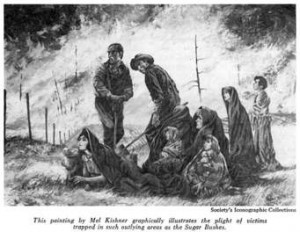 prolonged and widespread drought and high temperatures, capped off by a cyclonic storm in early October. The blaze began at an unknown spot in the dense Wisconsin forest. It first spread to the small village of Sugar Bush, where every resident was killed. There was simply no way of escape for them. High winds then sent the 200 foot flames racing northeast toward the neighboring community of Peshtigo. Temperatures reached 2,000 degrees Fahrenheit, causing trees to explode in the flames. The setting of small fires was a common way to clear forest land for farming and railroad construction. On the day of the Peshtigo Fire, a cold front moved in from the west, bringing strong winds that fanned the fires out of control and escalated them to massive proportions. A firestorm ensued. In the words of Novelist Denise Gess and historian William Lutz, “A firestorm is called nature’s nuclear explosion. Here’s a wall of flame, a mile high, five miles (8 km) wide, traveling 90 to 100 miles per hour (160 km/h), hotter than a crematorium, turning sand into glass.”
prolonged and widespread drought and high temperatures, capped off by a cyclonic storm in early October. The blaze began at an unknown spot in the dense Wisconsin forest. It first spread to the small village of Sugar Bush, where every resident was killed. There was simply no way of escape for them. High winds then sent the 200 foot flames racing northeast toward the neighboring community of Peshtigo. Temperatures reached 2,000 degrees Fahrenheit, causing trees to explode in the flames. The setting of small fires was a common way to clear forest land for farming and railroad construction. On the day of the Peshtigo Fire, a cold front moved in from the west, bringing strong winds that fanned the fires out of control and escalated them to massive proportions. A firestorm ensued. In the words of Novelist Denise Gess and historian William Lutz, “A firestorm is called nature’s nuclear explosion. Here’s a wall of flame, a mile high, five miles (8 km) wide, traveling 90 to 100 miles per hour (160 km/h), hotter than a crematorium, turning sand into glass.”
It would be impossible for most of us to imagine the way the people in that area felt that night. For so many of them, the way of escape, and with it, the hope of life disappeared in a matter of minutes. They didn’t know that the fire was coming until it had cut off their way of escape. Whole families were wiped out, and for the parents…well, I can’t imagine the sick feeling they had, knowing that they could not save their children. The fear the children must have felt, and the fear their parents shared with them…but, nothing could be done. They could only sit and wait for the end, trying not to speak the thoughts they were thinking…trying to give the children comfort and peace, even though their short lives were all they were going to get. So much has been learned over the years about drought and red flag (severe fire danger) days, but back then, they did not have the tools we have now, that can warn us of red flag situations, and even now, there are wildfires that destroy  miles and miles of land, and with it towns and homes. If that can happen these days, I can only imagine how easily it could have happened then. Many people have called the Great Peshtigo Fire, the forgotten fire, but in recent years America’s “forgotten fire” has proven to be anything but. The tragedy is a subject of inquiry and debate among meteorologists, astronomers and conservationists. It has been dramatized by novelists and playwrights. It continues to fascinate history buffs and frustrate genealogists, which is where I come in. While the list of the dead from the Great Peshtigo Fire, does not include names I know to belong to my family, the idea of a thousand people unaccounted for in any way, makes me wonder if some of the Wisconsin connections I have been unable to make could be among the lost ones of the Great Peshtigo Fire.
miles and miles of land, and with it towns and homes. If that can happen these days, I can only imagine how easily it could have happened then. Many people have called the Great Peshtigo Fire, the forgotten fire, but in recent years America’s “forgotten fire” has proven to be anything but. The tragedy is a subject of inquiry and debate among meteorologists, astronomers and conservationists. It has been dramatized by novelists and playwrights. It continues to fascinate history buffs and frustrate genealogists, which is where I come in. While the list of the dead from the Great Peshtigo Fire, does not include names I know to belong to my family, the idea of a thousand people unaccounted for in any way, makes me wonder if some of the Wisconsin connections I have been unable to make could be among the lost ones of the Great Peshtigo Fire.
 October 7, 1780, was the beginning of the end of British rule in The Colonies. The Battle of King’s Mountain would be a battle that the British would never forget. Fewer than one thousand American Heroes, used skills and strategies that no one expected them to have to defeat Major Patrick Ferguson, who was the star of the British military might. Benjamin, James, Robert, and Samuel Knox, ancestors of my husband, Bob Schulenberg, were four of those heroes. The Knox brothers walked away from the battle without being wounded. In reality so did most of the 900 Patriots who participated in the battle. In the end, while the number of casualties reported varies from source to source, some of the most commonly reported figures are that 225 Loyalists had been killed, 163 wounded and 716 were captured, while only 28 Patriots were killed, including Colonel James Williams, and 68 wounded. The outcome of this battle was disastrous for the British, and especially for Major Patrick Ferguson, who died there.
October 7, 1780, was the beginning of the end of British rule in The Colonies. The Battle of King’s Mountain would be a battle that the British would never forget. Fewer than one thousand American Heroes, used skills and strategies that no one expected them to have to defeat Major Patrick Ferguson, who was the star of the British military might. Benjamin, James, Robert, and Samuel Knox, ancestors of my husband, Bob Schulenberg, were four of those heroes. The Knox brothers walked away from the battle without being wounded. In reality so did most of the 900 Patriots who participated in the battle. In the end, while the number of casualties reported varies from source to source, some of the most commonly reported figures are that 225 Loyalists had been killed, 163 wounded and 716 were captured, while only 28 Patriots were killed, including Colonel James Williams, and 68 wounded. The outcome of this battle was disastrous for the British, and especially for Major Patrick Ferguson, who died there.
Major Patrick Ferguson came to North Carolina in September 1780, and with the plan of recruiting troops to join the Loyalist militia to protect the flank of Lord Cornwallis’ main force. Ferguson issued a ultimatum to the rebel militias to lay down their arms or suffer the consequences. Apparently, he didn’t understand the Patriots at all…not an unusual mistake for the enemies of the United States, even today. That ultimatum led them to react alright, but not in the way Ferguson had expected. The Patriot militia led by Benjamin Cleveland, James Johnston, William Campbell, John Sevier, Joseph McDowell and Isaac Shelby rallied for an attack on Ferguson. Major Ferguson, realizing the seriousness of his error, attempted to retreat to the safety of Lord Cornwallis’ army, but never made it.
The battle took place 9 miles south of the present day town of Kings Mountain, North Carolina in rural Cherokee County, South Carolina. Because the arrival of the Patriots was almost a complete surprise, the Loyalists suffered heavy casualties. The battle lasted just one hour, after which Major Patrick Ferguson lay dead, and his men, either dead, wounded, and/or captured, but not a single one of Fergusons men had escaped. The Patriots did have to retreat quickly, so they would not be there in the event of a counterattack from Lord Cornwallis’ army, but they left Kings Mountain completely victorious. It was the beginning of the end for British rule in the United States. No longer would The Colonies be looked at as simply fledglings in need of guidance, nor would they be looked at as a small insignificant army, but rather they would be respected as a worthy opponent.
Historians agree that the Battle of Kings Mountain was the “beginning of the end” of British rule in its former colonies. In less than one hour of battle, The Overmountain Men, as they were called, not only won the day, but also undermined the British strategy for keeping America under its control. Such a defeat, as that suffered by Major Patrick Ferguson, is rare in any war. Ferguson thought that his position on Kings Mountain was one that would make an attack nearly impossible, without advance warning. The plateau of the mountain was just large enough to serve as a battleground for his command and to provide space for his camp and wagon train. There was water nearby. The slopes of the mountain would hinder the advance of the attackers. When attacked he expected that any retreat would be rendered impossible by flanking or encircling detachments, a condition he desired, because he would see to it that his men stood and fought, rather than run away. From Patrick Ferguson’s point of view, there was no better position than the one he had found. How very wrong he was.

The Knox family went on to play an illustrious and important role in American history. They were descendants of Charlemagne and the British House of Plantagenet, established by Henry II and Eleanor of Acquitaine, whose exploits were told in the movie, The Lion in Winter. They were of the same family as Richard, the Lionhearted, King John who was forced to sign the Magna Carta, and John Knox, the famous Scottish reformer, who railed against the reign of Mary, Queen of Scots. This family produced the man who would become the eleventh President of the United States of America: James Knox Polk. They were a family that my husband’s family has long been proud to be a part of.
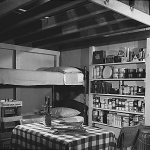 From the end of World War II, until the mid 1990s, the world was in the middle of the Cold War. The Soviet Union had developed atomic weapons, and they were threatening to use them. Tensions were high, because they were flexing all the military muscle they could. A common part of the administration was make sure that the people of the United States were ready for the very real possibility of an attack. The Eisenhower administration formed the Federal Civil Defense Administration (FCDA), later called the Office of Civil Defense, to instruct the people on what to do in the event of a nuclear attack.
From the end of World War II, until the mid 1990s, the world was in the middle of the Cold War. The Soviet Union had developed atomic weapons, and they were threatening to use them. Tensions were high, because they were flexing all the military muscle they could. A common part of the administration was make sure that the people of the United States were ready for the very real possibility of an attack. The Eisenhower administration formed the Federal Civil Defense Administration (FCDA), later called the Office of Civil Defense, to instruct the people on what to do in the event of a nuclear attack.
On this day, October 6, 1961, President Kennedy urged the people of the United States to build bomb shelters, so they could live through the nuclear fallout in the event of an attack. I was a girl of just five years, in 1961, but I vividly remember seeing those fallout shelters and knowing that it was possible that the day could come when we might have to take shelter there. That is pretty scary stuff for a five year old girl, but it was simply the world we lived in.
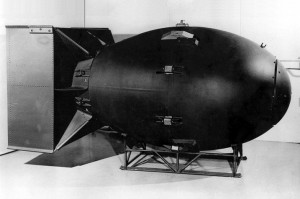 When I fast forward to this day and age, I have to wonder why some of the same precautions aren’t being put in place by this administration. We all know that Iran has nuclear weapons, and Russia, along with China, are beefing up their forces too. In many ways, the Cold War is in full force again, and no one seems to be reacting to the dangers. Maybe it is because we are getting used to the threat of nuclear war, but it still seems odd to me that there is not more preparation. Even I must admit that as a child, the fallout shelters were a source of unease for me, but now…even with the threat of nuclear war constantly in the news, I just don’t feel the same kind of concern…though maybe I should.
When I fast forward to this day and age, I have to wonder why some of the same precautions aren’t being put in place by this administration. We all know that Iran has nuclear weapons, and Russia, along with China, are beefing up their forces too. In many ways, the Cold War is in full force again, and no one seems to be reacting to the dangers. Maybe it is because we are getting used to the threat of nuclear war, but it still seems odd to me that there is not more preparation. Even I must admit that as a child, the fallout shelters were a source of unease for me, but now…even with the threat of nuclear war constantly in the news, I just don’t feel the same kind of concern…though maybe I should.
A fallout shelter was intended to reduce casualties in a nuclear war. It is designed to allow those inside it to avoid exposure to harmful fallout from a nuclear blast and its likely aftermath of radiation until radioactivity has dropped to a safer level. A basic fallout shelter consists of shielding that reduces gamma ray exposure. The most dangerous fallout has the consistency of sand or finely ground pumice, so a fallout shelter would not need to filter fine dust from air. The fine dust emits relatively little radiation. Concrete, bricks, earth, and sand are 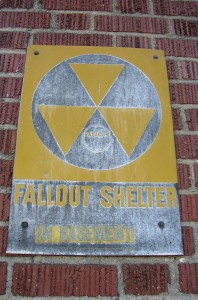 some of the materials that are dense or heavy enough to provide fallout protection. Basically this shelter could be much like a tornado shelter, except that it would need to have a door that seals completely.
some of the materials that are dense or heavy enough to provide fallout protection. Basically this shelter could be much like a tornado shelter, except that it would need to have a door that seals completely.
Concrete was the most often used building material of fallout shelters, with walls at least 12 inches thick. The required shielding could be accomplished with 10 times the amount of any quantity of material capable of cutting gamma ray effects in half. Shields that reduce gamma ray intensity by 50 percent include 0.4 inches of lead, 2.4 inches of concrete, 3.6 inches of packed dirt or 500 feet of air. I suppose the main concern for most of us the difficulty building one of these shelters, Nevertheless, that is exactly what President Kennedy urged the people to do, and what many of them did do. It was terrifying stuff, and it makes you wonder what is wrong with people who would even consider detonating one of these nuclear bombs.
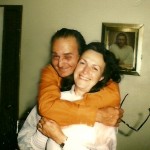 Our family always loved having our Aunt Ruth Spencer Wolfe, her husband, Uncle Jim Wolfe and their kids, Shirley, Larry, and Terry come to visit. We always had so much fun when they came. It didn’t matter if we were playing with the kids or sitting around listening to the many stories Uncle Jim or Aunt Ruth told. There was always so many fun things going on when they were there. My dad, Allen Spencer and Uncle Jim kept us all laughing with their antics. Dad and Uncle Jim were always coming up with some new thing…from wild recipes to crazy challenges. There was never a dull moment when our two families were together.
Our family always loved having our Aunt Ruth Spencer Wolfe, her husband, Uncle Jim Wolfe and their kids, Shirley, Larry, and Terry come to visit. We always had so much fun when they came. It didn’t matter if we were playing with the kids or sitting around listening to the many stories Uncle Jim or Aunt Ruth told. There was always so many fun things going on when they were there. My dad, Allen Spencer and Uncle Jim kept us all laughing with their antics. Dad and Uncle Jim were always coming up with some new thing…from wild recipes to crazy challenges. There was never a dull moment when our two families were together.
When we were kids, the two families took trips together. A favorite was the South Dakota trip. Our parents were great campers, and they always made it a lot of fun. I also remember several trips to Casper mountain. The mountain was a long standing favorite, because it was close and yet we got to 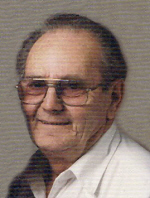 get out and camp, or at the very least, go for picnics. For a number of years, however, their family lived here in Casper, and that made it much easier to get together.
get out and camp, or at the very least, go for picnics. For a number of years, however, their family lived here in Casper, and that made it much easier to get together.
I gave us kids lots of time to play together. They had chickens, ducks, and geese, and for my sisters and me, all city girls, that in itself was a novelty. Of course, we didn’t have to clean up after them either. I think we were pretty prissy, and we would have probably freaked out at the site of the coop. They also had a garden, and in it was just about everything you could imagine, so I’m sure Aunt Ruth and Uncle Jim found a few things missing from the garden after we all spent time outside at their house. They also had a tractor that Shirley would hook the wagons up to and take us all for rides. It was a great time. Of course all too often, it was more fun to be inside with them. Our dad’s kept things lively, whether they were together or all by themselves.
For Uncle Jim’s kids, he was a role model. He taught them how to shoot a gun, and go hunting, so they could provide meat for their families. Their training started as young as two years old, and that is something I agree with. If children know what a gun can do, and they are taught the value of life, they will gain a healthy respect for both life and gun. Shirley recalls fishing, hunting and camping with her dad, and with that came a great  sense of camaraderie between the two of them. He was her hero, and she knew that he could do anything. I suppose that is part of what made it hard for her when his mind started to go. Suddenly the dad, who had always taken such good care of her and the family, needed her to take care of him. I know how she feels about that. It is a hard thing to know that your parents are aging, and all you can think is, “How can I stop this? I want to go back in time!!” Unfortunately, that can never be. We live the life we have been given, in the time we were meant to live in, and when it is time to go home to heaven, we must go, whether our family is ready or not. Today would have been Uncle Jim Wolfe’s 94th birthday. He left us almost 3 years ago, and we’ll always miss him. Happy birthday in Heaven, Uncle Jim. We love you.
sense of camaraderie between the two of them. He was her hero, and she knew that he could do anything. I suppose that is part of what made it hard for her when his mind started to go. Suddenly the dad, who had always taken such good care of her and the family, needed her to take care of him. I know how she feels about that. It is a hard thing to know that your parents are aging, and all you can think is, “How can I stop this? I want to go back in time!!” Unfortunately, that can never be. We live the life we have been given, in the time we were meant to live in, and when it is time to go home to heaven, we must go, whether our family is ready or not. Today would have been Uncle Jim Wolfe’s 94th birthday. He left us almost 3 years ago, and we’ll always miss him. Happy birthday in Heaven, Uncle Jim. We love you.

